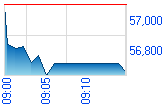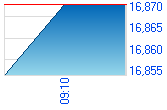With general elections due next year, the Railway Minister Mr Lalu Prasad tabled a people friendly Railway budget in the Lok Sabha on Tuesday. This budget was marked by good performance on both the freight and the passenger traffic fronts and a continued improvement in the operating ratio. The Railway Minister has attributed this performance to reduced fares/tariffs driving volumes and profits. The Railways continue on its profitable growth path and the accent continues to be on capital expenditure (capex) to make it more competitive.
Other highlights of this budget are reduction in passenger fares by 5% for second-class sleeper trains and reduction of 3-7% in fares for AC classes. The freight rates on petrol and diesel is reduced by 5% (by reducing its classification), whereas the freight on fly ash is cut by 14%. To further gain market share in the freight segment, the minister has taken initiatives like introduction of new wagon leasing policy and bulk and non-bulk goods terminal scheme. The budget also spells out the aim of using the public private partnership (PPP) model to offer door-to-door solutions including valueadded services like modern material handling facilities, warehouses and multi-modal logistic parks.
Performance review 2007-08
The financial performance of the Railways continues to improve. The revised estimates for 2007-08 show an increase of 2% in the gross traffic receipts, but a tight control on working expenses resulting in a robust growth of 20.1% in the net revenue receipts. Consequently, the operating ratio is likely to improve to 76.3% as compared with 79.6% budgeted figure and 78.7% reported last year. This operating ratio performance is the best in the last four decades. The cash surplus before dividend is expected to reach Rs25,000 crore by the end of this year against Rs20,000 crore last year. The net revenue for FY2008 is likely to be Rs18,416 crore and the dividend paid this year is Rs4,218 crore.
Railway budget for 2008-09
In the budget estimates for 2008-09, the gross traffic receipts are estimated to grow by 12.6% to Rs81,801 crore. However, the net traffic receipts are expected to decline by 11.7% to Rs15,211 crore as compared with the revised estimates of Rs17,234 crore in FY2008. This is largely
because of the ad hoc provision of Rs5,000 crore made for the liability arising from the implementation of the sixth pay commission (reflected in ordinary working expenses for FY2008BE). This is the key reason for the expected worsening of the operating ratio to 81.4% from 76.3% in the revised estimates of FY2008.
Freight
Freight rates have been reduced by 5% on petrol and diesel. The freight rate on fly ash has been reduced by 14%. This is beneficial for companies making blended cement, who use fly ash as a raw material, as their cost of raw material will go down. Freight loading till December 2007 has gone up 8.2% and the earnings from freight has been Rs33,447 crore. On this basis, the target for freight loading for FY2008 has been raised to 790 million tonne from 785 million tonne. The
target for freight loading for FY2009 has been kept at 850 million tonne. The freight loading target is 1,100 million tonne by 2011-12. To meet this target, the Railways have drawn up an industry wise approach. It is targeting traffic of 200 million tonne from the steel industry by 2011-12 from 120 million tonne at present. It is targeting another 200 million tonne in 2011-12 from the cement industry from more than 100 million tonne at present. Similarly it plans to garner freight from coal industry, port traffic and containerised business. In case of the coal industry, it plans to make most of the new dedicated routes for coal movement fit for trains, which can bear larger weight. In case of ports, it is giving priority to port rail connectivity projects. For containerized business, it plans to build more container depots so that the share of this business goes up.
Passenger traffic
This budget has reduced passenger fares by 5% for secondclass sleeper trains and 3-7% for AC classes. In addition 53 new trains and 10 new Garib Raths (low cost fully AC trains) will be started.
Vision 2025
The Railways plan to prepare a Railway Vision 2025 document, which will outline the Railway's strategy and preparedness for the future. This document will set out targets for the next 17 years and also a plan for achieving these targets. It will also contain details of various freight schemes to make Indian Railways more competitive.
Dedicated freight corridors (DFCs)
Work of the Eastern freight corridor (from Ludhiana to Kolkata) and the Western corridor (from Delhi to JNPT) have been sanctioned and the construction on both these projects will commence in FY2009. Detailed feasibility studies for the North-South, East-West, East-South and South-South DFCs are being carried out and the sanction for the construction of these corridors is likely in FY2009.
Modernisation
Railways have a high density network of 20,000 km, which needs to be modernised. The Railways plans to invest Rs75,000 crore over the next seven years to augment line capacity on these routes.
Public Private Partnership (PPP)
The Railways have drawn up a huge plan of Rs2,50,000 crore for the expansion, modernisation and upgradation of the technology in the next five years. Though the railways would resort to use of internal resources and borrowings, considering the huge amount, it has started many PPPs to attract an investment of Rs1,00,000 crore over the next five years. In 2008-09, concessions committing an investment of about Rs25,000 crore are likely to be awarded through the PPP route. The Railways is also looking at raising Rs4,000 crore in 2008-09 by making commercial use of the surplus land.
Live Online Trading News, Live Online Stock Prices NSE, BSE, Live Online Stock Recommendations
www.mReach.net ... for Live TV, Radio & FM channelswww.mReach.netFor Live TV, Radio & FM channels |
Live BSE Live NSE 
|
Wednesday, February 27, 2008
Railway Budget 2008-09
Please note: Some of the content in this site is from Share khan emails sent to its customers.